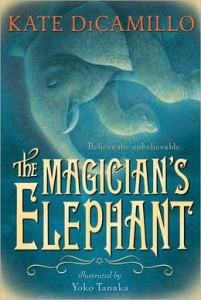 Review written by Jocelyn Koehler.
Review written by Jocelyn Koehler.
Are there kids out there who read the New Yorker? Because those are the only kids I can imagine loving The Magician’s Elephant. That’s not to say it isn’t beautiful and at times moving. But entertaining? Not so much.
Ostensibly, it’s the story of a young boy named Peter in search of his lost sister Adele. He receives a hopeful but cryptic message from a fortune teller, telling him that “the elephant will lead him there.” But lest you think this sign leads him on a bold quest, be aware that he instead just goes home to his cold apartment to await further developments.
Would this have gotten anywhere near a printing press if it didn’t have DiCamillo’s name on it? She’s a darling of kids’ lit. Because of Winn-Dixie was sweet. I didn’t actually care for The Tale of Despereaux, but at least that felt like a children’s tale. The Magician’s Elephant, however, feels like a very long prose poem. The language is carefully chosen, and often lovely. The words will send some youngsters to the dictionary (and others to the Xbox). The story is structured tidily. Everything falls into place, and we can see it falling, and like the elephant in the beginning, it seems to take a very long time to fall.
There isn’t a lot of text, but characters repeat, and repeat, and repeat the same lines. (Her: “Perhaps you do not understand…” Him: “I intended only lilies!”) A story as short as this should fly by, but this plods. I’d like to be nicer, but the fact is that the book bored me. Perhaps that’s because most of the characters don’t do much. They are certain things, but most of the story is just waiting for it all to come together, which in this case is the announcement by the elephant’s owner/jailer that the public can come see her for a day. That finally gets the ball rolling, since it gets all the characters into one location, and everything that could be said to happen happens very quickly after the initial elephant encounter.
Does it all end happily? Sure, in the sense that the characters mostly end up in the slots designated for them at the beginning. Siblings are reunited. The childless couple adopts them. The cranky old dude gets to become the eccentric uncle. The elephant returns to her homeland. All’s well that ends well.
SPOILER ALERT: Things you might want to know before suggesting this to your kid
Family
Family is portrayed as very important. Everyone secretly wants to be loved and held close and fed delicious soup. Most of the sadness in the story comes from the fact that families are separated (the young siblings), or incomplete (the couple can’t have kids). Once that’s solved, everything is implied to be hunky-dory.
Promises & Lies
The story hinges on how characters treat words. Peter feels guilty for his promise to his dying mother that he’ll take care of his sister (who is shortly separated from him). That guilt is what drives him to the fortune teller and ultimately through the story. Similarly, his guardian’s lie (that his little sister died) propels a lot of Peter’s anger once he hears from the fortune teller that she lives. Other characters are a little more complex; the magician claims to not have intended to conjure the elephant, but in his heart, he really did. Thus he feels guilt over the damage the elephant created, yet he can’t tell the truth or he’ll be punished further.
Mental Health
I was rather troubled by how easily Peter (and most of the other characters) fall into what only be described as deep depression. The story takes place in winter, and DiCamillo captures the hideousness of never-ending cold really well:
“It snowed and snowed until everything disappeared. The world itself soon seemed to cease to exist, erased, bit by bit, by the white of falling snow. In the end, there was nothing and no one in the world except Adele, who stood alone at the window of her dream, waiting.”
This passage is beautifully written, but the mood it sets is not meant to be peaceful or comforting. It instead highlights the loneliness and imprisonment of the powerless little girl. Unsurprisingly, DiCamillo’s language also encapsulates the dark logic of depression. Here are the elephant’s thoughts while she is being viewed like a circus freak:
“There were too many things she did not understand. Where were her brothers and sisters? Her mother? Where was the long grass and bright sun…
…The world had become too cold and chaotic to bear. She stopped reminding herself of her name. She decided that she would like to die.”
Yikes. Does the language resonate? Yes. Is the idea important? Yes. Is the crippling nature of depression actually discussed or made explicit in this book? No. That’s not what the story purports to be about; it claims to be about chasing your dreams and believing in the future. But the reader’s experience is 175 pages of doubt, darkness, and uncertainty, followed by 25 pages of eucatastrophic endgame, happy wrap-up, and elephantine exit strategies.
Recommendation
In case you couldn’t already tell, I have reservations about this book. Some of the imagery is truly beautiful, and the story may well resonate with the right kid. It’s also extremely short, so there’s no big commitment. If your kid is a big fan of DiCamillo, then they’ll probably want to read this anyway. If not…there are many, many other fine books on the trails of Mount ToBeRead.
The Magician’s Elephantby Kate DiCamillo
Published in 2009 by Candlewick Press





Speak Your Mind